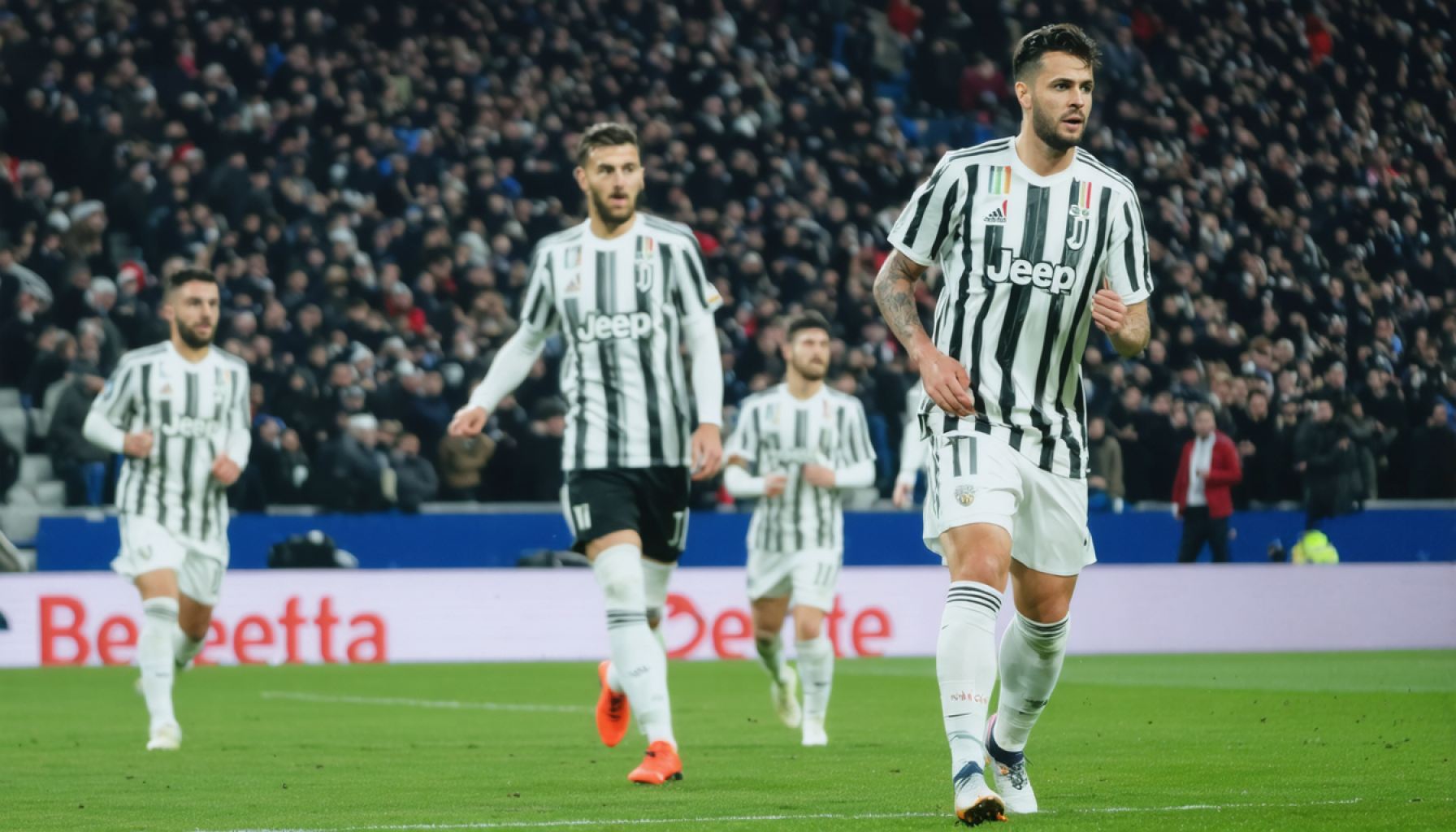- Juventus aims to overcome past inconsistencies in a crucial match, seeking redemption after a Champions League exit.
- Thiago Motta employs a strategic 4-2-3-1 formation with Di Gregorio, Weah, Gatti, Kelly, and Cambiaso fortifying the defense.
- Locatelli and Thuram anchor the midfield, empowering Conceiçao, McKennie, and Mbangula to drive offensive plays.
- Dusan Vlahovic plays as the solitary striker, backed by potential tactical shifts involving Randal Kolo Muani.
- Cagliari, led by Davide Nicola, counters with a 4-3-2-1 formation, looking for vulnerabilities in Juventus’s defense.
- The match represents an opportunity for Juventus to reassert its dominance and redefine its trajectory.
Amidst the electric prelude of an expectant crowd, the Bianconeri step onto the field, each stride a silent oath to reclaim their glory. The memory of a Champions League exit still raw, Juventus aims to shake off the specters of inconsistency that have shadowed them.
Inside the roaring stadium, fans witness a strategic recalibration. Thiago Motta, with tactical acumen, assembles a resilient 4-2-3-1 formation. The lineup features Di Gregorio as the steadfast guardian of the net, under the vigilant protection of Weah, Gatti, Kelly, and Cambiaso. As Locatelli and Thuram anchor the midfield, the dynamic trio of Conceiçao, McKennie, and Mbangula poise themselves to drive forward, energizing their lines of attack.
Much of the night’s focus rests on the potent Dusan Vlahovic, reinstated as the lone striker, his presence promising a decisive edge over adversary defenders. With Randal Kolo Muani poised on the bench, potential tactical maneuvers hover on the horizon, ready to shift the match’s balance.
Meanwhile, Cagliari’s warriors, hungry for their own vindication, prepare to face Juventus with determination. Coordinated by their strategic mind, Davide Nicola, the home team embraces a 4-3-2-1 strategy, hoping to capitalize on any chinks in Juve’s armor.
For Juventus, tonight is not just about points or prestige. It’s a confrontational journey—a chance to redefine the narrative and reassert a tradition of dominance rendered uncertain. As the countdown to kickoff dwindles, anticipation becomes palpable, promising a contest as much about resilience as it is about skill. The world watches eagerly: will this be the resurgence Juventus seeks?
Discover the Tactical Evolution Behind Juventus and Cagliari Clash
How-To Steps & Life Hacks: Navigating Game Day Strategies
Understanding the 4-2-3-1 Formation:
1. Defensive Structure: This formation provides a solid defensive base with four defenders and two central midfielders guarding the center.
2. Midfield Dynamics: The trio of attacking midfielders helps transition quickly from defense to attack, offering versatility against different plays.
3. Lone Striker Role: The striker benefits from ample support, enabling them to penetrate defenses effectively.
Life Hack for Fans:
– Using a Second Screen: Fans can enhance their viewing experience by following live tactical analysis on sports apps or social media. This provides insights beyond just watching the game.
Real-World Use Cases
This formation, famously used by teams like Real Madrid and Bayern Munich, focuses on both offensive fluidity and defensive solidity. Coaches often adapt these tactics based on player strengths and opposition analysis, making it a versatile choice in modern football.
Market Forecasts & Industry Trends
According to recent analyses, football tactics like the 4-2-3-1 remain popular due to their flexibility. They allow for quick transitions and adapting to real-time changes. As clubs focus increasingly on analytics, tactical innovation continues to shape team strategies worldwide.
Reviews & Comparisons
When compared to the more traditional 4-4-2, the 4-2-3-1 offers greater attacking support and midfield control. However, it demands players who can seamlessly switch roles, making it suitable for teams with versatile rosters like Juventus.
Controversies & Limitations
– Potential Weaknesses: If the attacking midfielders are caught out of position, this formation can leave the defense vulnerable to quick counterattacks.
– Player Fitness: It requires high levels of fitness from midfielders and wingers who cover extensive ground.
Features, Specs & Pricing
Player Analysis:
– Di Gregorio (Goalkeeper): Known for his agility and quick reflexes.
– Locatelli & Thuram (Midfield Anchors): Renowned for their ability to break up play and transition swiftly into attack.
– Dusan Vlahovic (Striker): A highly valued asset for his scoring prowess.
Security & Sustainability
Juventus’ adoption of a flexible tactic not only secures their defense but ensures sustainability, adapting to the evolving dynamics of modern football. By prioritizing youth development, they maintain a robust squad capable of implementing dynamic formations.
Insights & Predictions
As football tactics evolve, expect Juventus to integrate more data-driven decisions in their gameplay. This match serves as a litmus test for their strategic adaptability this season.
Tutorials & Compatibility
– For Aspiring Coaches: Online courses by platforms like Coursera and MasterClass focus on modern tactics, showcasing how formations like 4-2-3-1 can be effectively utilized.
Pros & Cons Overview
Pros:
– Versatile defensive-offensive transition
– Manages different game pressures adeptly
Cons:
– Demands high tactical awareness
– Can be susceptible to counterattacks if midfielders are out of place
Actionable Recommendations
– For Coaches: Regularly adapt and review tactical setups based on player performance and opposition analysis.
– For Fans: Engage with online communities post-game to discuss strategies and insights.
The anticipation is high for Juventus vs. Cagliari, promising to reveal much about both teams’ aspirations and tactical finesse.
For more on football strategies and trends, visit UEFA.
